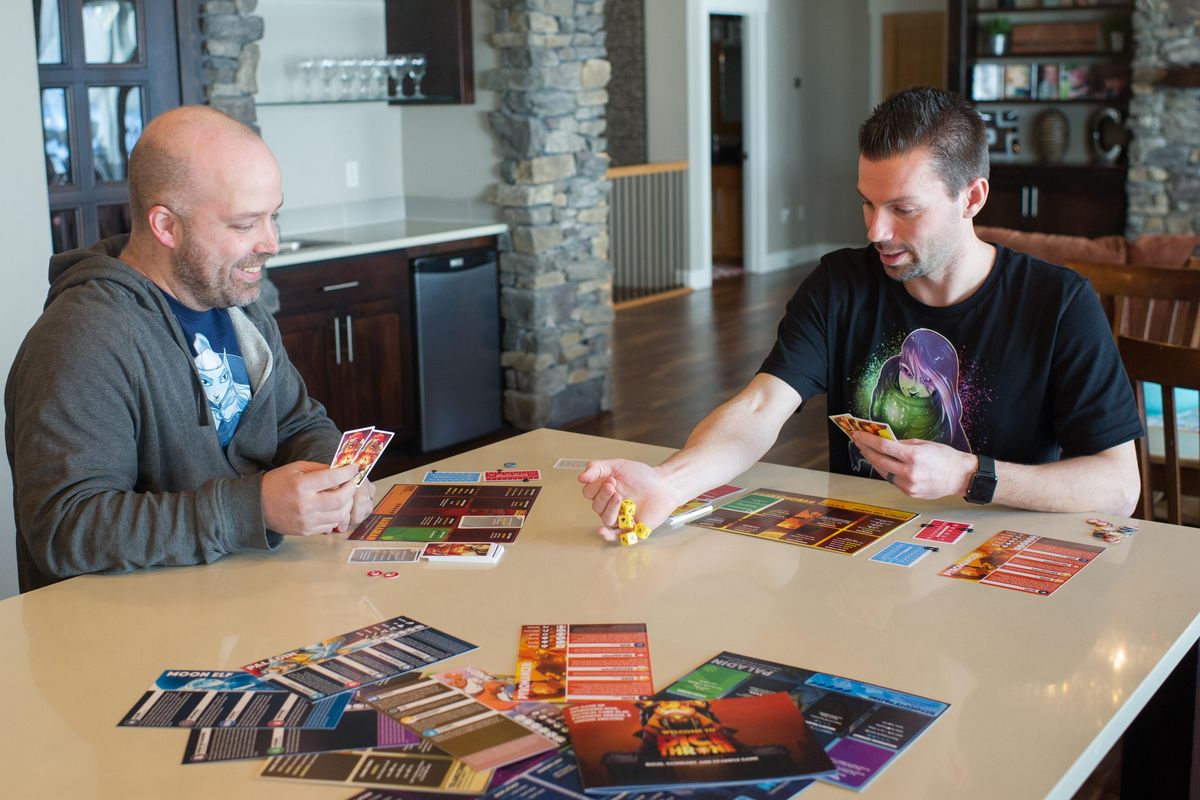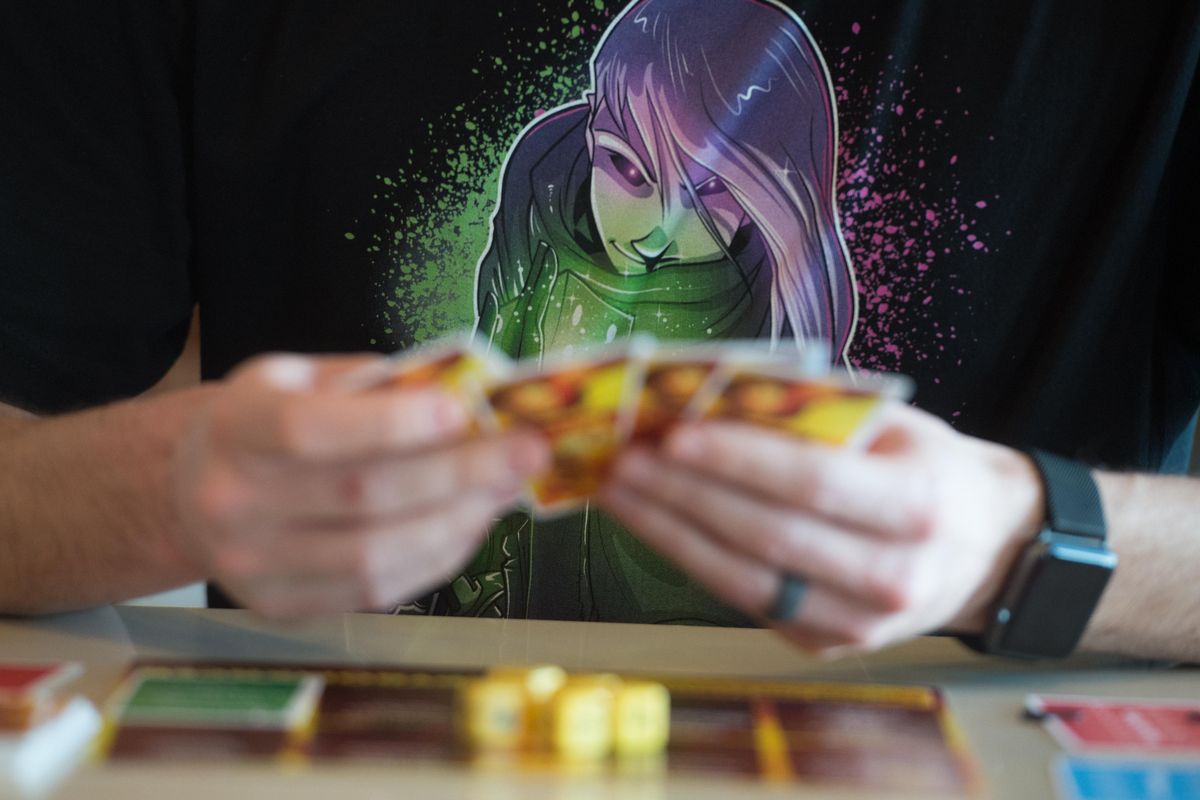Spokane software engineer’s new board game like a battle version of ‘Yahtzee’
Manny Trembley and Nate Chatellier, right, demonstrate “Dice Throne,” a game they created at Chatellier’s home in Spokane. TYLER TJOMSLAND tylert@spokesman.com (Tyler Tjomsland / The Spokesman-Review)Buy a print of this photo
Back in the 1980s, comic-strip character Calvin invented his own game, exclaiming,
“Other kids’ games are all such a bore!
“They’ve gotta have rules and they gotta keep score!”
Nate Chatellier can relate.
“I remember playing ‘Risk’ with my friends when I was 11. But it took too long and wasn’t interesting enough. And I thought, ‘What if I took the money from “Monopoly” and combined it with “Risk,” and modifying the game so you had to pay for your armies, pay to buy dice and pay to fly troops from one place to another?’ I reinvented what it meant to play ‘Risk,’ and I still think it’s a much better version.
“Since then I’ve made many tabletop games, never thinking about profiting from them.”
Until now.
This weekend, software engineer Chatellier and artist Manny Trembley are in San Antonio at PAX South, a hugely popular gaming convention, where they will unveil “Dice Throne” alongside six other new board games from around the country chosen for the PAX Indie Showcase.
“It’s a highlight of the weekend. They’ve done tons of marketing for us,” said Chatellier, “so we were thrilled.”
“Dice Throne” began as a videogame, Chatellier and Trembley’s bread and butter.
“But we’d never had to deal with the marketing side,” explained Chatellier. “We realized very quickly that we didn’t have the resources needed to launch this as a videogame.”
Yet even a cardboard version of “Dice Throne” is an expensive proposition.
So last week the pair launched a Kickstarter campaign. Their goal is to raise $15,000 in crowdfunding in 30 days.
“People can pledge at different levels, depending on whether they want the basic game or upgraded versions,” Chatellier said. “Twenty-nine dollars gets them the standard edition of ‘Dice Throne.’ For $39, they get an exclusive Kickstarter edition, with a unique box and special dice. For a pledge of $1,000, they can help us design a new hero. We can even make it look like them, if they want.
“We must raise at least $15,000 to manufacture the game,” Chatellier said. “If we don’t reach our goal, we don’t have a product and nobody gets charged. If we raise $20,000, we upgrade the quality of the cards. If we hit $30,000, we add a new hero.”
During a recent interview, Chatellier discussed his introduction to hacking, and working his way through college dressed as an eagle.
S-R: Where did you grow up?
Chatellier: I was born in Santa Paula, California (65 miles northwest of Los Angeles). I moved to Snohomish, Washington, when I was 12.
S-R: What were your interests?
Chatellier: Sports – particularly volleyball – and computers. I spent hundreds of hours on my Tandy computer. I remember playing Sid Meier’s “Civilization” when I was 10 or 11, and getting to a point where I was going to lose in two turns, no matter what. So I figured out how to hack the game, gave myself tons of money, and won. From then on it became more fun to dissect videogames than to play them.
S-R: Did you have a favorite class in high school?
Chatellier: Math.
S-R: What was your first job?
Chatellier: When I was 15, I got hired at a Subway restaurant, and became a manager at 17. I’ve always had a very strong work ethic.
S-R: Did you envision a particular career?
Chatellier: I knew I was going to be a game developer. I designed my first game – a silly shooting gallery – when I was 13.
S-R: Where did you go to college?
Chatellier: I did Running Start at Bellevue College, and graduated with an associate’s degree a week before I graduated from Monroe High School. Then I went to Eastern Washington University, where I majored in computer science and minored in math.
S-R: Any extracurricular activities?
Chatellier: I was Eastern’s mascot – the eagle – for three years. When I went to my first college football game, I was disappointed in our mascot. I had a background in dance and theater, so I contacted the athletic department and persuaded them to let me try out. I changed the mascot’s name to Swoop, came up with a theme song and dance routines, and they awarded me a full-tuition scholarship.
S-R: What did you do after college?
Chatellier: I worked five years for a company in town called DigiDeal, making electronic poker games. Then I spent seven years at Seven2, where I was lead developer on the popular “Finding Dory” Disney-Pixar game. Currently I’m with Niantic, the company that made Pokemon Go with Nintendo.
S-R: Where is Niantic based?
Chatellier: Sort of all over. My bosses are in L.A. and Chicago.
S-R: How does that work out?
Chatellier: Spokane is a difficult place to be for videogame development. All my jobs are based in Seattle and California and New York, and most videogame development is on site. Collaboration – looking over each other’s shoulder – is important. I’m fortunate that I’m the only developer on my project right now. And I love working from home.
S-R: How do you spend your days?
Chatellier: I sit for hours and hours at my computer, writing code. My Apple watch reminds me when it’s time to get up and move around.
S-R: Did the recession affect your industry?
Chatellier: Yes. And the saturation of games has been a major negative. It’s so easy to create games that app stores are flooded with them, making it difficult to get attention. Either you have to be well-known, advertise during the Super Bowl, or have a built-in audience, like “Finding Dory.”
S-R: What do you enjoy most about designing games?
Chatellier: I get paid to pursue my hobby.
S-R: What do you like least?
Chatellier: Supporting a game once it’s finished. I’m eager to move on to the next project.
S-R: Can you burn out on designing games?
Chatellier: Absolutely. There are what’s called triple-A titles – games with multimillion-dollar budgets – that take two to six years to make. I would never want to work that long on the same project.
S-R: Let’s talk about “Dice Throne.” Why Kickstarter? Why not come up with $15,000 yourselves?
Chatellier: If we do it that way, our risk goes way up. With Kickstarter there’s zero risk – either someone else pays the initial production costs, or you don’t make it. The only people who don’t use Kickstarter to fund board games nowadays are people who have a history of successful board games.
S-R: How do you generate interest?
Chatellier: Mostly on Facebook, Twitter and BoardGameGeek. Also, before you launch your Kickstarter campaign, you collect reviews. We sent prototype versions of our game to four professional board-game reviewers, and they made YouTube videos explaining the game.
S-R: How much do reviewers charge?
Chatellier: Most don’t charge anything. We get exposure, and they get content, which in turn means more subscribers. Reviewers with very large followings charge between $200 and $400. We got two free reviews and paid for two.
S-R: So how much are you into the game so far?
Chatellier: In hard costs, maybe $3,000. In hours, I’m afraid to measure that. Manny and I have each put in hundreds.
S-R: Is this meant to make money?
Chatellier: When you do your first tabletop game and you’re nobody, the amount of money you make is small. But if people like our games and trust us, we can launch more products, and hopefully those become more successful.
S-R: How do you describe your game?
Chatellier: It has elements of a very popular game called “Magic: The Gathering,” and another called “King of Tokyo.” For people unfamiliar with those games, we say it’s kind of a battle version of “Yahtzee.” Each hero has five unique dice, and you can roll them up to three times to activate an ability on your hero board and attack your opponent.
S-R: How long does it take to play?
Chatellier: Twenty to 30 minutes – it’s very fast.
S-R: Who’s your intended audience?
Chatellier: Our goal was to create a game that would appeal to both casual and competitive players. It’s easy to learn, but there are deeper strategies and tactics that will appeal to hard-core gamers.
S-R: Could there eventually be a digital version of “Dice Throne”?
Chatellier: We hope so. For that to happen, we need to prove that “Dice Throne” has an audience big enough to warrant a digital version. Our hope is that this version leads to many future expansions, just like “Catan” is an empire of game products.
S-R: What has this experience taught you?
Chatellier: In our minds, we thought, “You make a game and you’re done.” But it’s not just about making the game. It’s about building an audience that’s big enough to support the game’s production, distribution, price points, options. There are so many details.
S-R: “Dice Throne” is priced at $29 on Kickstarter. What’s your margin?
Chatellier: It costs roughly $9 or $10 a game to produce. We wanted to manufacture it in the U.S., but that would have cost $55 per game. So we’re having it made in China.
S-R: Looking back over your career, is there anything you wish you’d done differently?
Chatellier: I wish I’d lived somewhere like New York or London for a year or two before settling down.
S-R: What’s your greatest virtue?
Chatellier: I’m passionate about everything I do – which can get me into trouble.
S-R: When will you know whether “Dice Throne” is a success?
Chatellier: On Feb. 24, when the Kickstarter campaign ends. If we hit $15,000, we’ve succeeded.
This interview has been condensed. Writer Michael Guilfoil can be contacted at mguilfoil@comcast.net

